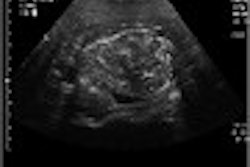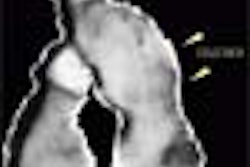(Ultrasound Review) According to Spanish gynecologists, although 3D sonography was useful for confirming conventional ultrasound findings, there was no additional benefit for patients with complex adnexal masses.
Differentiating benign and malignant adnexal masses with ultrasound continues to challenge diagnosticians. The group from the Clínica Universitaria de Navarra in Pamplona sought to determine whether 3-D transvaginal ultrasound might improve the assessment of adnexal masses.
Published in the Journal of Ultrasound in Medicine, the study evaluated 41 women that showed a complex adnexal mass sonographically. The radiologist that reported the 3-D images was unaware of the 2-D findings. A mass was considered complex when one of the following was evident:
- thick wall (>3 mm)
- thick septum (>3 mm)
- thick papillary projections (>3 mm)
- solid areas
- purely solid echogenicity
"Any multiloculated or uniloculated complex or solid mass with an echo texture that was not indicative of a benign histologic finding was categorized as malignant," the authors detailed. A malignant mass was considered when the following sonographic features were demonstrated: gross papillary projections, solid areas, and solid echogenicity.
Bilateral adnexal masses were present in three women, and so 44 adnexal masses were evaluated. All women had surgical intervention, and ultrasound findings were compared with surgical specimens. Malignancy was diagnosed and surgically proven in 47.7%. No significant difference was found comparing 2-D (sensitivity 90%, specificity 61% and accuracy 75% and 3-D (sensitivity 100%, specificity 78% and accuracy 89%.
Interestingly, 3D showed no false-negative findings, but there were two primary ovarian carcinomas that were considered benign on conventional 2-D.
They concluded, "the use of 3-D transvaginal sonography does not significantly improve the 2-D transvaginal sonographic morphologic assessment of complex adnexal masses; however, we found it useful for reinforcing initial diagnostic impressions."
According to the authors, surface-rendering mode was the most useful 3-D method for assessing adnexal masses. They did not discuss the use of color and pulsed Doppler ultrasound in assessing adnexal masses.
Three-dimensional sonographic morphologic assessment in complex adnexal masses: preliminary experienceAlcázar, J. L. et al.
Department of obstetrics and gynecology, Clínica Universitaria de Navarra, Pamplona, Spain
J Ultrasound Med 2002 March; 22:249-254
By Ultrasound Review
June 19, 2003
Copyright © 2003 AuntMinnie.com



















